- Home
- John Barth
The Friday Book Page 21
The Friday Book Read online
Page 21
In a moment I’ll pay my respects to Walt Whitman in the only way I competently can: by reading to you a few leaves of my own grass, from a project that perhaps suffers from some Whitmanesque ambition. Before I do, though, I want to tell you a complicated story of my discovery of two artistic uncles, one figurative and one literal: a discovery prompted by that remark of Leslie Fiedler’s.
It is a curious remark, after all: to say of our archetypal American poet, “Only such a European-oriented writer as Walt Whitman at his worst…” etc. That epithet reminded me of me. My memory of Leaves of Grass was an undergraduate memory; I reread it and recognized some kinship after all. Whitman’s project of going forward by going back, beyond the immediate European conventions of verse and their American imitations, to something older, looser, freer, more epical and rough—there were surely some resemblances there to my project of returning to the inventors of the English novel for my long story of Ebenezer Cooke, the misfortunate poet laureate of Maryland, in order as it were to make an end run around Flaubert and the modernist novel. So I discovered in Walt Whitman not a lost father, for better or worse, but a kind of mislaid literary uncle, who seemed to me to ratify, after the fact—benignly, avuncularly—my own project.
All right; that’s simple enough. Now comes the complicated part.
In 1873, in his fifty-fifth year, Walt Whitman suffered a partial paralytic stroke and retired from Washington here to Camden. Among his friends for the next number of years, here and across the river in Philadelphia, was a jolly circle of businessmen, physicians, clergymen, and more or less professional artists and goodfellows organized by and around the studio of one Colonel John R. Johnston, himself an artist of sorts. Johnston lived at 434 Penn Street in Camden, one block from this lecture hall; his Philadelphia studio became such a popular hangout for the wits of the area that they formed a mock society—after the model of the eighteenth-century Hartford Wits or the even older Tuesday Club of Annapolis, and all the earlier such mock orders in England and Europe, back at least to Plato’s Symposium crowd. Colonel Johnston dubbed himself The Chief; there were a Lieutenant General, a Marshal, an Attorney General, a Commissary, a Surgeon General, a Chaplain, a Chief of Old Pensioners, and a Poet Laureate. Not surprisingly, the Poet Laureate of the Studio was Walt Whitman.
They socialized; they drank; the artists drew serious or satiric drawings; the wits composed mock autobiographies, mock insults, mock book-reviews. All of it was pretty ponderous stuff, not nearly so witty as Joel Barlow’s Hartford crowd or the minutes of the Annapolis Tuesday Club. Whitman’s own contributions were rather straight: In 1880, at the peak of the group’s flourishing, he was sixty, fatigued, in indifferent health, and preoccupied with what was to be the big 1881 edition of Leaves of Grass. That same year, Colonel Johnston and his “Chaplain” (T. D. Caulston) availed themselves of a new invention called the hectograph to duplicate the sketches and the autograph inscriptions of the group, and published them as a handsomely bound volume called “The Studio Souvenir of John R. Johnston, Artist, First & Only Edition, Published in Philadelphia, February, 1880.” They ran off enough copies for each of the Studio’s habitues: those chief officers aforementioned plus a group listed as “Attendants on the Chief & Staff, as follows: Noblemen, Princes, rich men’s sons and millions expecting to be rich…” That last sounds like Whitman’s democratic touch, doesn’t it? Each copy—the printing numbered about three dozen in all—bore the owner’s name stamped in gold.
Here are a couple of Whitman’s entries, in his hand:
Feb. 9 ’80
Loafing around for a couple of hours this fine sunny crispy day—cross’d the Delaware—walk’d up Chestnut St—every thing lovely—look’d in at my friend Col. Johnston’s studio—the sun shining bright, & I feeling all right
Walt Whitman
Camden N J
At 434 Penn Street
Sunday Evening
Feb 15th ’80—
Another fresh, dear, social evening here, with Col. & Mrs. Johnston, & Ida, & John (an evening fine as I have had, over & over again for six years). Next summer early (May 31), I shall be 61 years old.
—I have just return’d from a four months’ trip to the Rocky Mt’s, and over the Great Plains, & through Colorado, Missouri, Kansas, Illinois, Indiana, Ohio, &c.
Am well for me—
Walt Whitman
And a final one, undated, toward the end of the book:
Nothing does me more good than to have a little shake up with the boys of the Studio.
Walt Whitman
Now the plot thickens. One of those “boys” Whitman refers to happened to be a forty-year-old Baltimorean named James H. Wilson (I am reading from his copy; he is listed among the Attendants), who describes himself as being “in the steamboat business.” By 1908, twenty-eight years after The Studio Souvenir was published and sixteen years after Whitman’s death, Wilson’s copy was evidently floating around another sort of studio, a more serious one: the old Maryland Institute of Art on Mount Royal Avenue in Baltimore. That year, somehow, it came into the possession of a young sculpture student at the Institute named Herman Barth. After the manner of Colonel John Johnston and his friends, young Herman inscribed and dated the book with elaborate nineteenth-century flourishes and had many of his studio friends do the same. On some of the flyleaves, superimposed upon their signatures, they made Rorschach-style ink blots (Hermann Rorschach himself was twenty-four at the time, working in Switzerland, and hadn’t yet developed his famous ink-blot test).
I never met this uncle of mine—my father’s older brother and the only artist I know of among my ancestors. Herman Barth graduated from the Maryland Institute of Art, worked a few years in Baltimore as a stonecutter while practicing the art of sculpture, went to France in 1918 with the American Expeditionary Force, looked foward to visiting the Louvre (so says one of his last postcards home), but died before he got there, in the great influenza pandemic of 1918/19, a dozen years before I was born. But I have thought about him a lot, this young sculptor sprung from the large family of a German immigrant tombstone-cutter, my grandfather, whose arrival in America coincided with the ’81 edition of Leaves of Grass. I’ve wondered whether Uncle Herman would have “made it” as an artist, had he lived: whether he’d have outgrown the academic conventions of his time and gotten in on the ground floor of modernism, for example, or become just another master mason. And whether, in either case, he might have taught me useful things.
Just about the time of Leslie Fiedler’s review of The Sot-Weed Factor, when I was beginning to find my own way in my own medium, my father gave me some of my late uncle’s effects: a few pieces of Beaux-Arts plaster statuary—classical copies and imitations, student work—and a couple of his books, including James Wilson’s copy of John Johnston’s Studio Souvenir, in which I found the Whitman holographs, my uncle’s flourishing autographs and doodles, and those proto-Rorschach ink blots.
Well. Jorge Luis Borges says in his essay on Kafka that every writer creates his own precursors. This is the opposite of Professor Harold Bloom’s argument that great writers are as it were created by their precursors—by their struggles against and pacts with their spiritual fathers. Borges also says, in an essay on Walt Whitman, that Whitman, who had no immediate precursors, invented himself: the colossal democrat, the Good Gray Poet who no doubt shared a few characteristics with the Camden invalid who bore his name, as Borges admits to sharing a few with the Argentine writer named Jorge Luis Borges.
As for me, I didn’t invent, nor was I invented by these two uncles, the figurative and the literal, whom I rediscovered together by this curious chain of coincidences; by whom I feel obscurely but benignly—that is to say, avuncularly —ratified; to whom I give this nephewlike wave of the hand.
Now, for my second problem…
My Two Muses
FALL, 1978: the LETTERS novel all but done at last, and this final variation on the twin-problem theme, at a conference on Myth and Modernism spo
nsored by the Classics Department at the University of Wisconsin at Milwaukee.
In a university as programmatically contemporary as this one, with its distinguished and formidable Institute for Twentieth Century Studies, I find it a comfort to be the guest of the Classics Department. As an undergraduate at Johns Hopkins in the 1940s, while I was cutting my writerly teeth on Joyce and Kafka and discovering that literature existed, it was my good fortune to work part-time as a book-filer in the library stacks of Greek and Latin classical literature and of W. F. Albright’s Oriental Seminary. I read so much of what I was supposed to be reshelving that to this day I don’t know whom to blame the more for my own literary productions: the High Modernists or the tale-tellers of antiquity.
My particular interest in classical mythology, as distinct from classical literature, is a tale quickly recounted. When my novel The Sot-Weed Factor appeared in 1960, several critics remarked that it showed the influence of Otto Rank and the comparative mythologists. I had not in fact read Rank and company; I quickly did, and found the critics to be correct. Indeed, as I wandered through Jung and Lord Raglan and Joseph Campbell and the rest—the way I’d once wandered through the Classics stacks—I became fairly obsessed by the detailed abstract pattern, the actuarial profile, of wandering heroes in the myths of the world’s cultures. That cyclical model tyrannized my imagination. I was quite aware that one arrives at such a level of generality as the Ur-Mythe, or Monomyth, only by ignoring enough particularity; I knew that to a cultural anthropologist, say, the differences between the adventures of Perseus and those of Watu Gunung might be more significant than their similarities. No matter. I was also aware of the several profound things that this general model was alleged to signify, or at least to correspond to: the circuit of the seasons, the rites of passage, the crisis of individuation, the psychoanalytical deep-dive, the mystic transcension of categories into undiflerentiated Being. But I confess that it was the model itself I loved, quite apart from its multiple significations, and whether or not it turned out to be, after all, just another fallible nineteenth-century-style synthesis.
That is the confession, I suppose, of an unreconstructed formalist. It is also the confession of a failed musician whose youthful ambition was to be neither a composer nor a performer, but an orchestrator—what in those big-band days was called an arranger. And that’s my real bond with the authors of antiquity, for whom originality was chiefly a matter of rearrangement. I wrote a long comic orchestration of the abstract model (Giles Goat-Boy) and a number of short stories and novellas based on particular manifestations of it: the story of Menelaus and the Old Man of the Sea; the story of Narcissus and Echo; the story of Perseus and Medusa; the story of Bellerophon and the Chimera. These are beautiful, wonderful stories—I mean the originals. Indeed, my problem—since my muse is ineluctably the comic muse—was not to trivialize, in my reorchestrations, those splendid melody-lines that moved and touched me so profoundly: the great myths themselves.
I’m not sure I succeeded. In any case, that particular obsession is behind me now, replaced by others. But the capital-P Pattern continues to reverberate through the long work that I have been holding by the tail—and it me by the throat—since 1972, when the last of those “mythological” stories was published.
Tonight I want to read to you two excerpts: one from the mythological comedies, as advertised, and one from the novel in progress. That novel, I almost blush to report, is a reorchestration of one of the oldest and riskiest of novel-forms: the epistolary novel, long since pronounced kaput by the coroners of literary criticism. But it happens that in addition to being a disappointed orchestrator, I am a bona fide honorary Doctor of Letters, who likes to take that distinction in its medical sense (Johns Hopkins is, after all, both my alma mater and my present employer), and who therefore makes it part of his business to administer artificial respiration to the apparently dead, whether the patient is the classical myths or certain exhausted conventions of the novel. So…
The Future of Literature
and the Literature of the Future
AT A SYMPOSIUM on the subject above, held at the University of North Carolina at Chapel Hill in 1976, I seem actually to have spoken to the topic, perhaps for mere relief.
To speculate about the literature of the future, what it might be like, is to beg at least two much larger questions. Let’s do it, breathtaking as those twin presumptions are: namely, that the future will contain, in some no doubt attenuated form, that we have got used to calling Western Civilization; and that in that civilization the survivors will continue to produce and consume something like what we have got used to thinking of as literature.
Cleanth Brooks and Robert Penn Warren’s textbook definition of literature will do: “the artistic rendering of human experience into words.” I shall qualify it with the adjective written words, to distinguish what I imagine to be our subject from, on the one hand, stage plays, operas, films, television dramas, and laser holography or whatever gets invented next, and on the other hand from the oral tradition out of which written literature springs and toward which, in a modest way, it has been inclining since the 1960s, when live readings became more popular than they’d been since the nineteenth century and some of us began to explore the possibilities of electronic tape as a medium for fiction and poetry.
I am no prophet. Furthermore, I’m not very interested in prophesying the future of the arts: a category of speculation wherein—unlike energy development or international relations—the consequences of erroneous prediction approach zero. On the Baltimore Beltway, between Exit 19 and Exit 20, there is another exit sign very plainly marked FUTURE; but if you spend your time looking for the ramp, you just go around and around Baltimore instead of getting where you want to go. My profession is the opposite of soothsaying: A writer of fiction spends his time making up stories attractive enough to induce people to spend their time reading what he writes precisely despite the presumption that it’s all made up in his head. That is a mystery I only half understand, though my living depends upon it.
There is a historical connection between prophesy and poetry. Between prophesy and prose fiction, that connection gets debased (some would say elevated) into “science fiction”: fiction about the future, which of course is no more the same thing as the fiction of the future than science fiction is the same as scientific fiction. I shall not concern myself here with science fiction.
For what one storyteller’s opinion is worth, I’ll hazard ayes, at least a probably, to both of our great presumptions aforementioned. As to the first: I am not particularly optimistic about the rest of this century and the next one, to look no farther, but I’m not quite apocalyptic about them, either. The only view of history that squares with my experience, education, and intuitions is the tragic view; I see no reason not to extend it to the future as well. Elizabeth Bishop has called ours “the most dreadful human century,” and perhaps she’s right: To think about what we’ve done to our planet and to one another in the last seventy-five years is almost unbearable. But the nineteenth century was a horror show, too: the butchery of the Napoleonic wars, the butchery of imperial colonialization. And consider the centuries before that: catastrophic, every one of them. I try to believe Jacob Bronowski’s affirmation (in his television series The Ascent of Man) that humankind is in fact ascending despite Dachau and Auschwitz and the “Gulag archipelago”; I guess I finally do believe it, if only because I’m a healthy, moderately successful white American with a color TV set and enough leisure to watch The Ascent of Man. But oh, my: Capitalism really does seem to be ruinously exploitative and inherently self-destructive; large-scale socialism is dreary, bureaucratic, inefficient, stifling; anarchy is impossible; everything else is repressive and authoritarian at best, totalitarian at worst, and especially noxious for artists and intellectuals. I fear that we’re in for catastrophic nuclear accidents before the century’s done; maybe even at least limited thermonuclear wars, heaven forfend. Surely cataclysms of overpopulation,
inadequate food production and distribution, and insufficient energy lie down the road for our children if not ourselves to suffer. We may be ascending, but the cost is immeasurable and the ascent so gradual that we’ll need all the Bronowskis we can find to assure the survivors that they’re going up at all. That’s what I mean by the tragic view.
Compared to the first, the second presumption seems insignificant, though for some of us it would be a necessary condition of civilization that it have a written literature. Literature will no doubt be indispensable as long as language is indispensable, and written literature is important, if not necessary, exactly for its peculiar limitations, which people like Marshall McLuhan made so much of in the 1960s. These limitations (I’m going to call them virtues, but characteristics is a more accurate term than either) can be summed up in four adjectives: written literature is semiotic, anesthetic, linear, and solitary. I shall now speak to these adjectives one at a time, in reverse order.
First, solitary. Literature is the only art I can think of that is normally both produced and consumed, or received, by individuals as individuals. Its audience is one person at a time even when everybody on the beach is reading Jaws or Ragtime (they’re not at all at the same word at the same moment; even if by extraordinary coincidence they were, their experience wouldn’t be communal as the experience of a concert or even a symposium is). Reading is as private as thinking or dreaming, exactly; one imagines that it will be valued (and permitted) as long as private thinking and dreaming are valued and permitted.

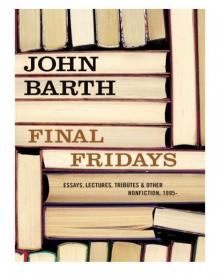 Final Fridays
Final Fridays Where Three Roads Meet: Novellas
Where Three Roads Meet: Novellas Every Third Thought: A Novel in Five Seasons
Every Third Thought: A Novel in Five Seasons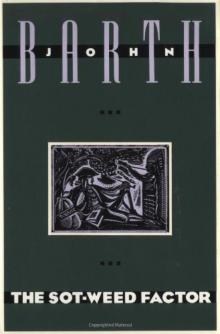 The Sot-Weed Factor
The Sot-Weed Factor The Friday Book
The Friday Book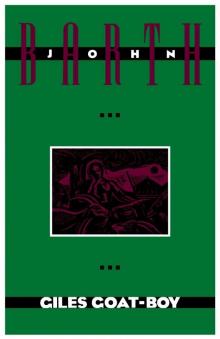 Giles Goat Boy
Giles Goat Boy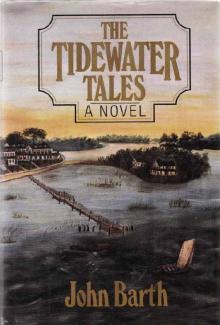 The Tidewater Tales
The Tidewater Tales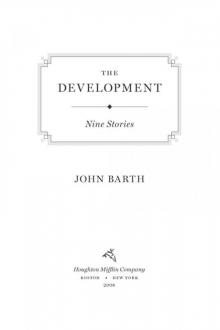 The Development
The Development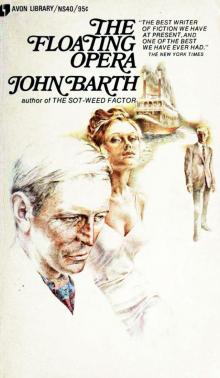 The Floating Opera
The Floating Opera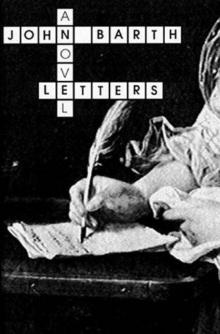 Letters
Letters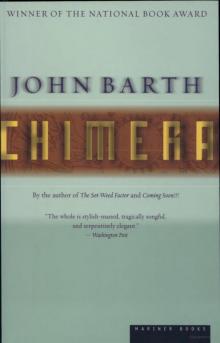 Chimera
Chimera Where Three Roads Meet
Where Three Roads Meet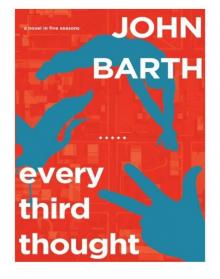 Every Third Thought
Every Third Thought